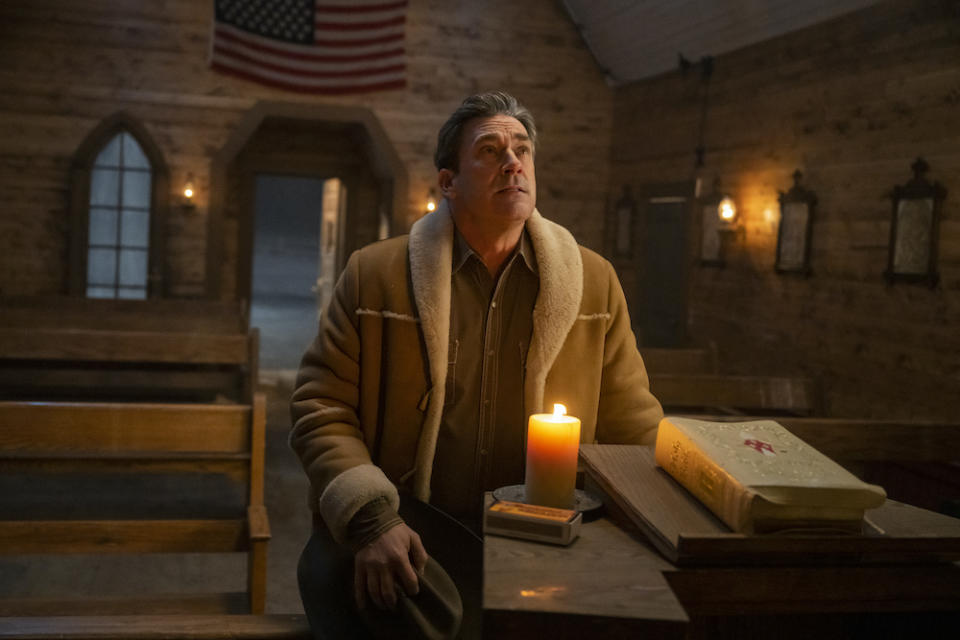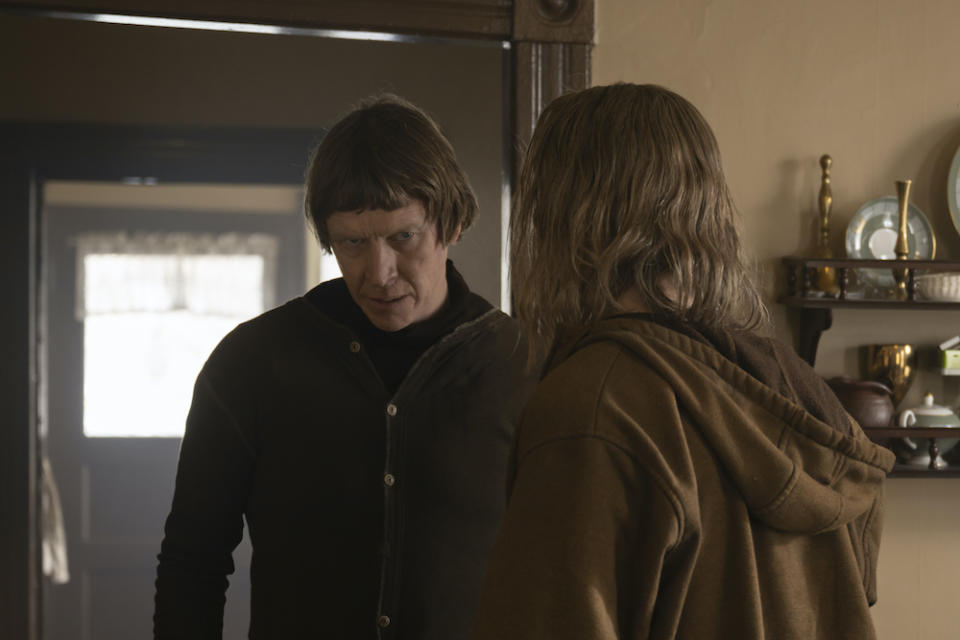‘Fargo’ Season 5 Settles Its Debts in Riveting Finale

[Editor’s Note: The following interview contains spoilers for “Fargo” Season 5, Episode 10, including the ending.]
Amid the dead bodies (R.I.P. State Trooper Witt Farr) and scorched faces (remember Donald Ireland?), it can be hard to keep track of all the grievances, allegiances, and debts incurred in “Fargo.” But Mr. Munch (Sam Spruell) doesn’t forget. Like an elephant with the shortest nose and worst haircut you’ve ever seen, the assassin once hired to kidnap Dorothy “Dot” Lyon (Juno Temple) returns to her home well over a year after he first broke in. Then, he lost a lot of blood (not to mention his partner) in the ensuing skirmish, and now, he would like to see his debt of “flesh” repaid.
More from IndieWire
'The L Word' Pilot Turns 20 - Amid the Worst LGBTQ Backslide in Television History
'Schmigadoon!' Season 3 and Its 25 New Songs Aren't Happening at Apple
“Why,” Dot asks him. “Why must debt be paid? I understand keeping a promise, but people always say, ‘Debt must be paid.’ Except… what if you can’t? If you’re too poor or you lose your job, maybe there’s a death in the family. Isn’t the better thing, the more humane thing, to say that debt should be forgiven? Isn’t that who we should be?”
Thrown for a loop by Dot’s kindness, Munch enters into the oddest sort of negotiations: making biscuits while weighing whether or not to attack this beautiful family. For a moment, his indignant conviction returns, as he remembers being tricked by a deceptive act of generosity. “The food was not food,” he says. “It was sin — sins of the rich.” Perceiving her dinner guest’s shift in demeanor, Dot remains calm. She does not lash out to protect her family, like she did a year prior. Instead, she says, “It feels like that, I know — what they do to us. Making us swallow, like it’s our fault. But do you want to know the cure? You’ve got to eat something made with love and joy, and be forgiven.”
Munch does, and then, he is. “Fargo” Season 5 ends with a shot of his jagged teeth forming a jubilant smile, as Dot, the tiger, breaks bread with her fellow predator, bringing innocence and hope back to them both.
The full circle moment speaks not only to the (excellent) season’s stirring culmination, but one for the series as well. “Fargo” Season 5 was widely hailed for reinvigorating the franchise. It built on the anthology’s rich history to progress its message, and it did so by doubling down on established strengths, while simultaneously speaking to the present and evolving for the future.
Showrunner, writer, and director Noah Hawley’s earliest ambitions for the next “Fargo” were simple: After a “slightly bigger” Season 4 — with 23 main characters spread across a “1950s crime epic” — he “wanted to scale down and do something that felt tighter overall.” He also wanted to tell a “contemporary” story, but his first spark of an idea came from thinking back on the Coen brothers’ original feature.
“When I was thinking about the movie, there are all these great characters — Jerry Lundegaard (William H. Macy), Marge Gunderson (Frances McDormand), Carl Showalter (Steve Buscemi) — but the one who was at the center of the story, the kidnapping victim, didn’t really have a voice.”
Hawley said that worked perfectly for the movie, but it also “presented an interesting possibility” for a season of television. “It’s something I like to do every season,” he said, “to take these Coen brothers moments and kind of revisit them, but have something else happen.”

From there, “Fargo” Season 5 sprang to life via familiar grooves and challenging ideas. Two opposing forces — Dot and Sheriff Roy Tillman (Jon Hamm) — are set on a collision course. A talented ensemble works to keep them apart and then smash them together. There’s a snowy Minnesotan countryside, misconstrued manners, and mysterious moments aplenty (like Munch’s Latin ritual and the imaginary puppet show).
Hawley knows these staples well, having steered every season of “Fargo” thus far, but he re-familiarized himself in a way that paid dividends for Season 5’s focus and drive.
“One thing I did do, which I had never done before, is I went back and watched all the seasons of ‘Fargo’ before I got started [on Season 5],” Hawley said. “I edit them so much and spend so much time on them that once the season is done, I sort of don’t look back at it. But after 41 hours, it felt that maybe I would go back and see.”
Hawley watched them out of order — “I think it was [Season] 3, then 2, 1, and 4 — and picked up on various commonalities that then developed further in Season 5. One had to do with the “world of the American Right,” which Hawley said was top of mind after “living in research” for his latest novel, “Anthem” (a staggering tale both in its scope and subject matter). But right-wing extremism has long surfaced as a malevolent force in his Midwestern anthology series.
“There is this paradox, this hypocrisy, this contradiction where, in the first three seasons of ‘Fargo,’ there was always a moment where the worst person in the show said, ‘I’m the victim here,'” Hawley said. “We’ve lived through and are still living through an era where the most powerful man in the world was both claiming to be a victim and also saying, ‘If I do it, it’s not a crime, but everything you do is a crime.’ So [writing] the lawman who doesn’t actually enforce the laws was interesting to me.”
Thus, Jon Hamm’s sheriff with nipple rings and a “sex trunk,” as Hawley called it, was born. Hawley felt the specificity of those much-discussed elements lent Sheriff Tillman the necessary authenticity he seeks for all his characters, even while embodying a wide swath of the MAGA movement.
“The reality is, if you look at the American Right, those days of the moral majority, the buttoned-up, Bible-thumping world have really shifted,” he said. “‘Turn the Other Cheek Jesus’ has become ‘Warrior Jesus’ and America has become ‘Tiger King’ America. There’s a weird hedonism that’s kind of moved into it.”
Another key recurring theme in “Fargo,” Hawley said, was “deconstructing the phrase, ‘This is a true story,'” which frames every episode. Season 3 was the first to really zero in on alternate facts and individual realities, culminating in an ambiguous ending where one character stands behind truth and justice, while the other is backed by “facts” he’s altered for his own benefit. We never learn whose reality proves out.
“The fake story is real because it’s been proven in a court of law,” Hawley said. “And to argue with that is like arguing with the rivers and the rocks. That’s a fact now, even though it never happened, and that idea feels inherently Coen-esque and Kafkaesque.”
Season 5 takes that idea and runs with it, toying with reality in a number of ways while coming to more definitive resolutions for each character. Dot denies she was kidnapped, despite enormous evidence to the contrary. Sheriff Tillman repeatedly distorts the truth in order to preserve his power, exacting justice as he sees fit. If a corrupt cop says one thing happened, and it didn’t, but the law abides by the report, what’s the truth? And if a victim denies any wrongdoing when plenty of wrong actually went down, what happens to the predator?
“This world of alternative facts, this world of ‘you see it your way, I see it my way,’ and it’s like, ‘Well, hold on. It’s either hot out or it’s not’ — it’s not a matter of opinion, but for a lot of people it is a matter of opinion or perception,” Hawley said. “That sense of living outside of reality is really afflicting us in many ways right now.”
“The real question over the course of the season is: […] Dot is a victim of abuse in her past, but can she face up to reality in order to be a healthy person?”

Yes she can, it turns out, just as Tillman may not be able to face the reality he’s created for himself. Both characters are given unambiguous endings — hers happy, his much less so — in a way that befits their moral successes and failings. Of course, “Fargo” has offered clear conclusions before, but Season 5’s manages to be both vicious and human, fitting and honest.
Finally, beyond his rewatch of “Fargo,” Hawley also learned something from rewatching one his favorite Coen brothers’ movies — no, not that one.
“I don’t rewatch [‘Fargo’] that often,” Hawley said. “What was interesting was when I went back and re-watched ‘No Country for Old Men,’ I saw Tommy Lee Jones’s character in a totally different light. You have Anton Chigurh [Javier Bardem] and you have Josh Brolin’s character, Llewelyn Moss, and these are the sort of lone wolf characters who [believe]: ‘I’m going to solve my own problem. I don’t need the law.’ And I always felt like Tommy Lee Jones’ [character] really stood apart. He was a sheriff, he had this common sense and winning way, and we really liked him.”
“But when you really look at the symbology of it, [the sheriff] keeps being asked, ‘Do you want to go back to the crime scene and meet the federal cops?’ And he keeps saying, no. He keeps being giving the opportunity to cooperate with the rest of law enforcement, and he keeps refusing. He’s reinforcing this idea that the justice system is either incompetent or corrupt, and I think those are dangerous myths.”
Hawley said he’s as guilty as anyone of falling into similar depictions of the justice system, citing Bob Odenkirk’s “incompetent” boss in “Fargo” Season 1, the “obstructionists” blocking Ted Danson and Patrick Wilson’s honorable lawmen in Season 2, and Shea Whigham’s sheriff was “just an asshole” in Season 3.
“In Season 5, I wanted to tell a story that championed the system of justice versus one man is the law,” Hawley said. “My hope was by saying, ‘All right, we have the state cop that Lamorne Morris plays, and we have the local cop that Richa Moorjani plays, and we have this FBI, and the way that they’re going to solve this is to work together — against the ‘I am the law’ guy [Sheriff Tillman]. We need those stories now that reinforce for us that that’s how justice is done. It takes a lot of people. It’s a cooperative effort.””In Season 5, I wanted to tell a story that championed the system of justice versus one man is the law,” Hawley said. “My hope was by saying, ‘All right, we have the state cop that Lamorne Morris plays, and we have the local cop that Richa Moorjani plays, and we have this FBI, and the way that they’re going to solve this is to work together — against the ‘I am the law’ guy [Sheriff Tillman]. We need those stories now that reinforce for us that that’s how justice is done. It takes a lot of people. It’s a cooperative effort.”
“For better or worse, we’re all in this together.”
Dot and Munch, after breaking bread in the same room as her (alleged) kidnapping, would have to agree. Not all debts have to be paid. Forgiveness is one thing, accountability another, and we’ll need to communicate with each other if we’re going to pinpoint either one.
“Fargo” Seasons 1-5 are available on Hulu.
Best of IndieWire
Sign up for Indiewire's Newsletter. For the latest news, follow us on Facebook, Twitter, and Instagram.

 Yahoo News
Yahoo News 
